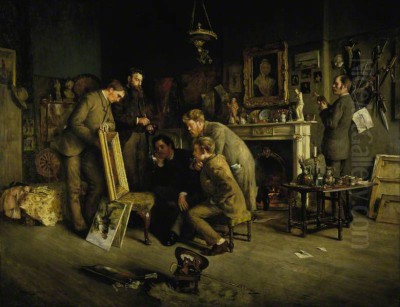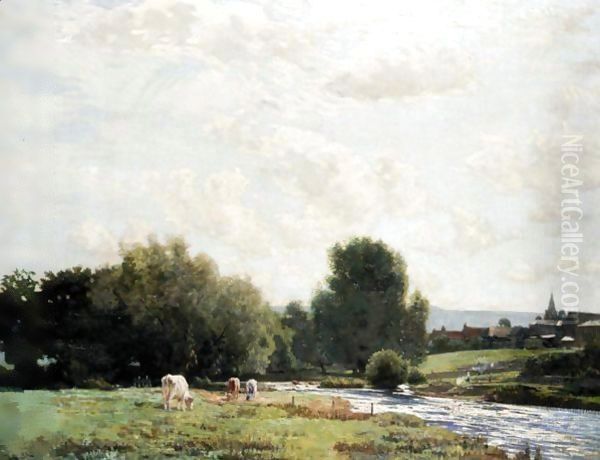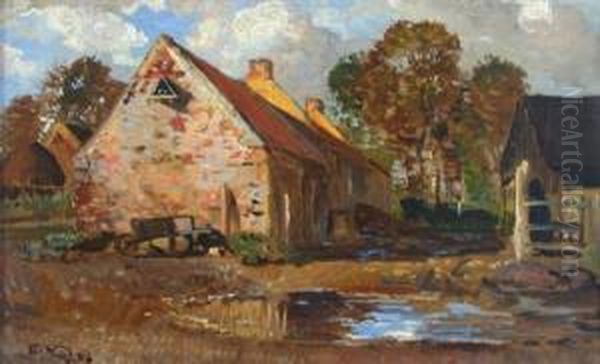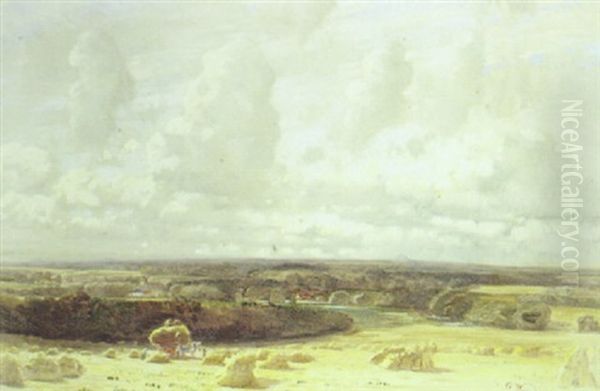
Robert Noble stands as a significant figure in the landscape of Scottish art during the late nineteenth and early twentieth centuries. Born in Edinburgh in 1857 and passing away in 1917, Noble dedicated his career primarily to capturing the scenic beauty of Scotland, particularly the East Lothian region where he spent a considerable part of his life. He is best known for his vibrant depictions of the countryside, often featuring motifs like rustic watermills, blossoming orchards, and fields ripe for harvest. His work occupies an interesting space, absorbing influences from contemporary European movements like French Impressionism while remaining rooted in established traditions of British and Scottish landscape painting. This blend resulted in a distinctive, if sometimes debated, artistic output.
Noble was not merely a painter confined to his studio; he was also an active participant in the Scottish art world. A key moment in his career was his role as a founder and the first President of the Society of Scottish Artists (SSA) in 1891, an organization established to offer alternative exhibition opportunities to those provided by the more established Royal Scottish Academy (RSA). While he did exhibit his works in London and potentially further afield, his reputation and recognition were predominantly cemented within Scotland, where his colourful canvases found favour with audiences and fellow artists alike.
Early Life and Artistic Formation
Robert Noble's connection to the Scottish landscape began early. Although born in Edinburgh, his formative years and much of his adult life were deeply intertwined with East Lothian, specifically the village of East Linton. He resided there for around thirty years, living for a time at Drylawhill with his family during his first marriage. This long immersion in the local environment provided him with an inexhaustible source of inspiration, allowing him to develop an intimate understanding of the region's light, seasons, and characteristic features – elements that would become central to his art.

His artistic training was significantly shaped by his relationship with his cousin, Campbell Noble (1845-1897). Campbell, also an artist, served as Robert's teacher. This familial and pedagogical connection likely provided Robert with his initial grounding in technique and perhaps influenced his early stylistic direction. While details of other formal training might be sparse, this mentorship under an established family member was crucial. It set him on a path towards landscape painting, even though some accounts suggest his earliest works might have included interior scenes and figure studies before he fully committed to the outdoor subjects that would define his career.
The environment in which Noble developed was rich with artistic activity. Scotland, particularly Edinburgh and Glasgow, had vibrant art scenes. The established Royal Scottish Academy provided a benchmark for quality and tradition, while emerging groups and influences, including French plein-air painting and Impressionism, were beginning to make their mark. Noble navigated this context, absorbing lessons from tradition while cautiously engaging with newer trends, a dynamic that would become evident in his mature style.
Artistic Style: Impressionism Meets Tradition
Robert Noble's artistic style is often characterized by its engagement with French Impressionism, particularly in its use of colour. His palette tended towards brightness and warmth, a departure from the more sombre tones often associated with earlier Scottish landscape traditions. He wasn't afraid to employ vibrant greens, rich blues, and sunny yellows to convey the atmosphere of the scenes he depicted. This affinity for bright, often decorative colour has led some commentators to note an influence from the French painter Adolphe Monticelli, known for his richly textured and jewel-like surfaces.
However, Noble's Impressionism was tempered. While he embraced a brighter palette, he did not fully adopt the broken brushwork or the emphasis on capturing fleeting moments of light and atmosphere that defined core French Impressionists like Monet or Pissarro. His work retained a strong sense of structure and design. Compositions were carefully considered, often complex, balancing elements like trees, water, and architecture within the frame. There was a clear emphasis on technical proficiency and a finished quality, suggesting a reluctance to completely abandon academic principles.
This combination of influences led to a style that, while visually appealing, sometimes drew criticism. Some contemporary and later critics found his work to possess a certain artificiality or mannered quality . The bright colours and elaborate compositions could, at times, feel more decorative than deeply evocative of nature's raw essence. The figures sometimes included in his landscapes, occasionally described as ornately dressed, might contribute to this sense of staged beauty rather than spontaneous observation. It was felt by some that his adherence to certain artistic conventions limited the emotional depth and the sense of immediate, novel impression in his paintings.

Despite these critiques, Noble's technical skill was widely acknowledged. He demonstrated a strong ability in drawing and composition, and his handling of paint, particularly in rendering textures and foliage, could be highly effective. He possessed a distinct ability to weave together different landscape elements, such as woodlands and pastoral fields, into harmonious wholes. His preference for warm, luminous colour schemes gave his paintings an undeniable charm and decorative appeal, contributing to their popularity during his lifetime. He developed a unique way of seeing and representing the East Lothian landscape, even if it was filtered through his particular stylistic lens.
Themes and Favourite Subjects
The heartland of Robert Noble's artistic output was the East Lothian countryside. Having lived there for three decades, he developed a deep familiarity with its specific locations, seasonal changes, and rural life. This region became his primary subject matter, revisited time and again throughout his career. His paintings serve as a visual record of this corner of Scotland at the turn of the twentieth century, capturing its enduring pastoral character.
Among his most favoured and recurring themes were watermills. The River Tyne flowing through East Lothian powered several mills, and these structures, with their blend of the man-made and the natural, clearly appealed to Noble's compositional sense. Preston Mill, a particularly picturesque watermill near East Linton, is thought to feature in several of his works, its distinctive conical-roofed kiln and weathered stone walls offering rich visual potential. These mill scenes allowed him to explore the interplay of water, architecture, and surrounding foliage.
Orchards in blossom or laden with fruit were another common subject. These paintings often celebrated the arrival of spring or the abundance of autumn, providing opportunities for Noble to indulge his love of bright, decorative colour. The patterns of blossoming branches against sky or grass allowed for intricate designs, while the theme itself evoked a sense of fecundity and rural tranquility. Similarly, scenes of harvest time, depicting fields of cut grain, stooks, and perhaps distant figures gathering the crops, captured the culmination of the agricultural cycle and offered further scope for warm palettes and textured landscapes.
While landscapes dominated his mature work, it's noted that his earlier career may have included more interior scenes and figure studies. This suggests a deliberate shift in focus, a conscious decision to specialize in the genre where he found most success and perhaps personal resonance. His landscapes rarely feel empty; even when figures are absent or small, there is often a sense of human presence implied through cultivated fields, paths, or buildings. His skill lay in integrating these elements into a cohesive vision of the Scottish countryside, emphasizing its picturesque and productive aspects.
Career, Exhibitions, and the Society of Scottish Artists

Robert Noble pursued a successful professional career within the Scottish art establishment. He became a regular exhibitor at the prestigious Royal Scottish Academy (RSA) in Edinburgh. His talent was formally recognized by the Academy when he was elected an Associate (ARSA) in 1892, and later a full Academician (RSA) in 1903. Achieving RSA status was a significant mark of esteem, confirming his position among Scotland's leading painters. His works shown at the RSA exhibitions would have included many of his characteristic East Lothian landscapes.
Beyond the RSA, Noble sought broader platforms for artists. Recognizing a need for more diverse exhibition opportunities, particularly for younger or more progressive artists who might find the RSA's structure limiting, Noble played a pivotal role in founding the Society of Scottish Artists (SSA) in 1891. He served as the Society's first President from 1891 to 1894. The SSA aimed to be more inclusive and international in outlook than the RSA, organizing large annual exhibitions that showcased a wide range of styles. Noble's leadership in its formative years was crucial to establishing the SSA as an important and enduring feature of the Scottish art scene.
While his primary focus remained Scotland, Noble also exhibited his work further afield. Records indicate he showed paintings in London, likely at the Royal Academy and possibly other venues. Participation in London exhibitions was important for any ambitious British artist seeking national recognition. There may also have been opportunities to exhibit internationally, perhaps in Paris or Munich, as was common for successful artists of the period, though his main successes were achieved within Great Britain, particularly Scotland. His consistent presence in major Scottish exhibitions ensured his work was well-known to the public and collectors in his home country.
His connection to specific locations extended beyond East Linton. Some sources mention a link to Fife, another region of Scotland known for its picturesque landscapes and coastal scenes. It's possible he painted there or had connections with artists based in Fife, further broadening his engagement with the Scottish landscape. Throughout his career, Noble maintained a steady output, building a reputation as a reliable and accomplished painter of colourful, well-designed landscapes that appealed to the tastes of the time.
Notable Works
While a comprehensive catalogue raisonné might be lacking, several works by Robert Noble are known and help illustrate his style and typical subjects. Pinpointing exact dates for all works can be challenging, but titles often recur in exhibition records and auction results.
One frequently mentioned title is "East Linton" or variations thereof, such as "Springtime, East Linton" or "An East Lothian Village". These works directly reference his home base and likely depict familiar views of the village, the River Tyne, or the surrounding fields. "Springtime, East Linton," for example, would likely showcase his skill with bright, fresh colours, capturing the blossoming trees and vibrant greens of the season in the manner described – decorative yet grounded in observation.
Paintings titled "The Water Mill" or specifically "Preston Mill" are central to his oeuvre. These would feature the rustic architecture of the mill, often reflected in the water, surrounded by lush foliage. Noble would likely have focused on the textures of stone and wood, the movement of water, and the play of light on the scene, composing these elements into a picturesque whole. These works exemplify his interest in the intersection of human activity and the natural environment.
"Harvest Time" or "Harvest Time, East Lothian" represents another key theme. Such paintings would typically depict golden fields, possibly with figures engaged in agricultural labour, under warm, sunny skies. These scenes allowed Noble to explore a warmer palette, focusing on yellows, golds, and browns, and to capture the sense of abundance and the culmination of the farming year in his favoured East Lothian setting.
Other titles that appear include "An East Lothian Garden," suggesting more intimate scenes perhaps featuring flower borders and garden paths, allowing for rich colour and detailed rendering of flora. Works depicting orchards, either in blossom or with fruit, would fall under similar thematic categories. While perhaps less known for coastal scenes, given East Lothian's proximity to the sea, it's possible some seascapes or coastal views exist within his body of work.
Examining these works, even through reproductions, confirms the general assessment of his style: strong design, bright and often warm colour, competent technique, and a focus on the picturesque aspects of the landscape. They show an artist confidently handling his chosen subjects, creating appealing images that celebrate the beauty of his local environment through his distinct artistic vision.
Contemporaries and Artistic Context
Robert Noble worked during a dynamic period in Scottish art. He was a contemporary of several significant artists, and his work should be understood within this broader context. His cousin and teacher, Campbell Noble (1845-1897), was naturally his earliest artistic connection. Campbell himself was a landscape painter, providing a direct lineage within the genre.
The dominant figure in Scottish landscape painting during the preceding generation and overlapping with Noble's early career was William McTaggart (1835-1910). McTaggart is often considered Scotland's leading Impressionist, known for his vigorous brushwork and atmospheric depictions of seascapes and rural life. While Noble's style was generally more controlled and less radically Impressionistic than McTaggart's, he would certainly have been aware of McTaggart's work and the broader trend towards capturing light and atmosphere more directly.
Noble was also contemporary with the Glasgow Boys, a group of painters who emerged in the 1880s and challenged the dominance of the Edinburgh establishment (the RSA). Key figures included James Guthrie (1859-1930), E. A. Walton (1860-1922), Arthur Melville (1855-1904), and John Lavery (1856-1941). While Noble was primarily associated with Edinburgh and the East Lothian area, and his style differed from the often more naturalist or Whistler-influenced approaches of some Glasgow Boys, they were part of the same artistic generation seeking new modes of expression and reacting against older academic conventions. The formation of the SSA, which Noble led, can be seen partly in the context of this desire for alternative venues, similar to the spirit that animated the Glasgow School.
Within the RSA circle, Noble would have known and exhibited alongside many established landscape and figure painters. These included artists like J. Lawton Wingate (1846-1924), known for his atmospheric landscapes, often depicting sunsets and twilight; David Murray (1849-1933), a successful landscape painter who later moved to London; A. K. Brown (1849-1923), another prominent landscape artist; and R. B. Nisbet (1857-1942), known for his watercolour landscapes. Coutts Michie (1859-1934) was another contemporary active in landscape and portraiture. Earlier figures whose influence might still have been felt included George Paul Chalmers (1833-1878), admired for his rich handling of paint and atmospheric interiors and landscapes.
The influence of French painting was pervasive during this period, not just Impressionism but also the Barbizon School's emphasis on rural naturalism (e.g., Millet, Corot), which had significantly impacted earlier Scottish artists. Noble's work reflects this complex interplay of native traditions, the legacy of the Barbizon school, and the newer impulses from French Impressionism, filtered through his own temperament and technical approach. His role in founding the SSA placed him at the centre of efforts to broaden the scope of Scottish art exhibitions, suggesting an awareness of and engagement with these diverse contemporary currents.
Legacy and Assessment
Robert Noble RSA holds a secure place in the history of Scottish art as a prominent landscape painter of the late 19th and early 20th centuries, particularly noted for his colourful depictions of East Lothian. His legacy is twofold: firstly, through his artistic output, and secondly, through his contribution to the institutional landscape of Scottish art.
As an artist, Noble is remembered for his distinctive style that blended elements of Impressionism, particularly its brighter palette, with a more traditional approach to composition and finish. His paintings of watermills, orchards, and harvest fields captured the picturesque beauty of his chosen region with technical skill and a strong sense of design. While his work has sometimes been criticized for a degree of artificiality or lack of profound emotional depth compared to some contemporaries, its decorative qualities and celebration of rural Scotland found considerable favour during his lifetime and continue to attract admirers. He successfully created a recognizable niche, becoming strongly associated with the East Lothian landscape.
His institutional legacy, primarily through the Society of Scottish Artists, is perhaps equally significant. As a founder and its first President, Noble was instrumental in establishing an important alternative exhibiting body in Scotland. The SSA provided a crucial platform for artists working outside the immediate orbit of the Royal Scottish Academy, fostering diversity and encouraging broader artistic trends. This organizational role demonstrates Noble's commitment to the health and dynamism of the Scottish art world beyond his own practice.
Compared to the more radical innovations of William McTaggart or some of the Glasgow Boys, Noble might be seen as a more conservative figure, albeit one who embraced colour more readily than many academic painters. He represents a particular strand of Scottish painting at the turn of the century – competent, colourful, rooted in local landscape, and engaged with contemporary trends but ultimately committed to well-crafted, accessible pictures. His work provides valuable insight into the tastes and artistic currents of the period and remains a testament to the enduring appeal of the Scottish landscape.
In conclusion, Robert Noble was a dedicated and productive painter whose life and work were deeply connected to the East Lothian region of Scotland. His colourful landscapes, influenced by but distinct from French Impressionism, earned him recognition within the Scottish art establishment, including full membership in the Royal Scottish Academy. His role in founding the Society of Scottish Artists further cemented his importance. While critical assessments may vary regarding the depth of his work, his skill in composition, his characteristic use of colour, and his evocative depictions of watermills, orchards, and fields ensure his continued relevance as a notable figure in the rich tapestry of Scottish landscape painting.